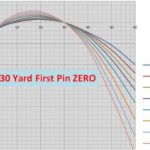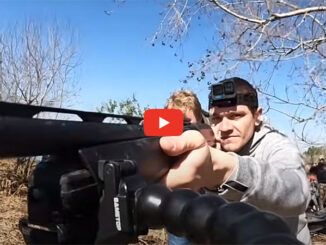
Arrow speed is key in setting first pin
Suddenly, I spotted the deer creeping silently on a foggy Mississippi River ridge. The doe was broadside, upwind and unaware of my presence, but was already passing through my 35-yard shooting gap. Only one last window remained before it disappeared into the brush for good.
In a regular situation, this would’ve been easier, but things are a little trickier because I film all of my public land bowhunts, and there’s never a moment to spare.
In less than five seconds, the camcorder was pointed and rolling, the Tactacam button pressed, the Contour was flipped on, and the GoPro remote was blinking red.
Now it was time to put the arrow on the bullseye. Check out video of the shot here.
A deer can drop a full 12 inches before an arrow reaches 20 yards, and this shot was over 35, so I didn’t bother making noise to alert the doe of my presence. With a brain to muscle-response time faster than .15 seconds, a deer looking in my direction would likely dodge an arrow with ease in the almost half-second it takes for it to arrive.
Using my wife’s opposite-handed bow, all I knew was to line up the second pin and activate the release. The red Nockturnal sailed through the river’s mist into the deer at the perfect height, and the doe was down.
Through extensive Internet research of rare arrow trajectory charts and my own hours of testing with a chronograph and different bows, I was able to create some trajectory charts which allow me to set the first pin at the furthest distance possible for the flattest shooting.
The charts are not 100 percent true-to-scale with all of the variables in archery, but they are meant to provide some basic understanding of what the arrow does once it is launched. I don’t want to get into a heated debate on speed versus momentum in this article, so this focuses only on understanding arrow trajectory and pin placement ideas.
In compound bowhunting, the vast majority of shots are within 30 yards. Instead of having to worry about using the commonly 20- and 30-yard pin setup, it can be more efficient to use one pin to cover this entire distance —or even further — with today’s fast bows.
The odd thing is 20 or 30 yards is not necessarily the best distance to put a first pin. Examine the chart and read more to learn why.
Similarly to how a rifle being used for open field hunting is more efficient with a 200-yard zero versus a 100-yard zero, I use this same principal in my archery equipment.
By utilizing the flatter flight of the arrow’s initial trajectory, your first pin can be set on most modern compound bows beyond 30 yards with no estimations or ranging needed. How far to set this pin is determined by one factor – speed.
Just like the path of a bullet through a scope’s crosshairs, an arrow starts several inches under the aim of the first pin before it quickly crosses above — then below — the first pin’s aim on its inevitable path to the ground.
Also, with one-pin sites becoming more and more popular, knowing the arrow’s trajectory is even more important so longer ranges can be known past that one pin’s distance to make quality shots.
The first pin on my 70-pound Mathews Feathermax and my wife’s 60-pound PSE Fever, which both shoot arrows around 288 fps, is 26 yards. My second pin is 35 yards, and that’s followed by pins at 40, 45 and 50 yards. (After 35 yards, the arrow drops significantly at this speed, which I why I use 5-yard increments.)
The five pins on my fast PSE Full Throttle, which slings arrows over 330 fps, are at 31, 40, 50, 60 and 65 yards. The first pin can be set at any distance, but it all depends on how high over the line of aim you want your arrow to be.
If the usual trajectory of having a 20-yard first pin is used, only a quarter to 1-inch high arrow peak at around 13 yards is achieved with average compound bows. However, with this method, any shots beyond 20 yards will require more and more estimation, as there can be large drop before the next pin.
With slower compound bows, this drop can average around 7 to 9 inches before reaching that 30 yard pin —nearly an inch per yard.
With my strategy, the upmost trajectory never travels over 2inches from the first pin’s aim. Keeping it under 2 inches means no aiming compensation is needed within my initial pin’s yardage for a deer’s vital zone. The arrow will reach this 2-inch vertical peak around the 18- to 20-yard mark. As it falls over that next 2 inches, the zero distance of the first pin is determined by the arrow’s speed. Rough estimates of the most efficient first-pin distance according to speed are labeled on the chart.
Also, the arrow will be within 3 inches of this zeroed distance for a few more yards extending beyond the first pin’s range. This gives an effective “shot window” (which is described in chart) totaling 31.5 yards with my wife’s bow and 38 yards with my Full Throttle. Hold that first pin on the center of the vitals within those distances, and you’ve got a dead deer.
In most hunting situations, getting a perfect range on the animal is rarely an option. Estimations from previously ranged or marked-off locations must be used, and human error is always a factor. So with more range on the first pin, many shots are easier to connect on — if only my friend had known this.
He was ready. He had scouted, set stands, cut shooting lanes and then patiently waited for that perfect wind. The conditions were finally correct on a mid-December afternoon, and a big old rack was heading his way. The first buck he would ever get a chance at with a bow was upon him.
Only one problem arose: With the deer moving too quickly to range, he had to decide on his 20- or 30-yard pin to sling his 283 fps arrow. He chose 30 — and he chose wrong.
The arrow sailed right over the back of the buck, which was standing at 26 yards. With a supreme trajectory 25-yard first pin for that arrow speed instead of his pin set at 20 yards, the deer would likely have been slain whether it was right next to him or all the way out at 30 yards.
In my mind, deciding from 2 to 30 yards is much easier in the moment of truth than trying to pick the right pin for 20, 25, or 30 yards.
I asked several of my bowhunting buddies just how far under or over the line of sight their arrow was even before their first pin, and none had any clue. It wasn’t until after I told one friend that the arrow usually starts about 4 inches under the line of sight that a hunting story’s tragic mystery was finally solved.
He had shot under the belly of a giant buck in the Midwest that was right under his stand. He had aimed low using his first pin at 30 yards without understanding arrow trajectory. Little did he know that arrow would be shooting low for the first few yards of flight — not high as he thought.
His arrow would have only shot over the first pin’s aim from roughly 7 to 29 yards. If a target is nearly underneath you, aiming a couple of inches high is key. Also, note that a higher angle to the animal leaves the deer’s vitals reduced in vertical area, making the trajectory even more important to know.
Last year, another friend also had his Midwest trip ruined. He had a huge buck come in broadside at 30 yards, but in the brief seconds to shoot, he used his 20-yard pin thinking the deer was closer than it was.
Even with a very expensive bow launching his arrow at 303 fps, the trajectory was too low and he only ended up finding bloody white hair and wounding the deer. With a 29-yard first pin, he would’ve most likely had the buck of a lifetime, instead of a heartbreaking experience.
Not ranging an animal correctly is a common theme in missed or lost archery-shot deer, and it’s a subject I’m unfortunately familiar with after missing a bear this year in Colorado.
My best advice for sighting-in the first pin is to study these charts and see what plus or minus trajectory is best-suited for your needs. Then, practice.
No one has taught me a thing on arrow trajectory. After 15 years of practice, along with loads of research and common sense, I constructed this method. Many animals have been cleanly struck with my extended first pin — with less need for precise ranging.
In the game of chasing whitetails on public land with arrows, the cards are always stacked in the deer’s favor. I like to increase my odds with knowledge of arrow trajectory so my broadheads continue to find their mark.






